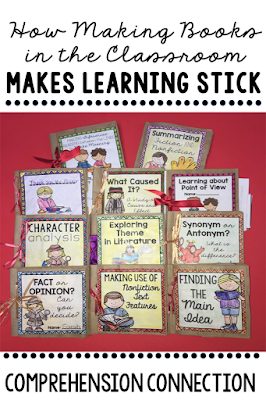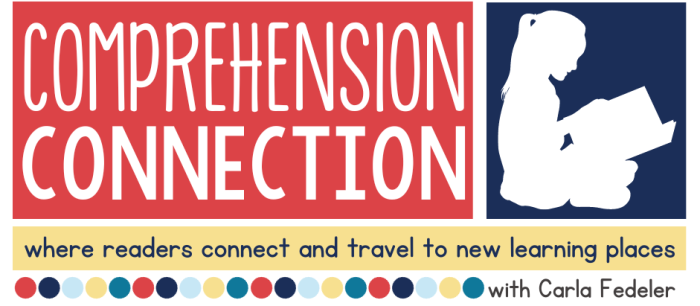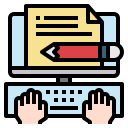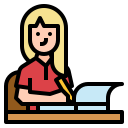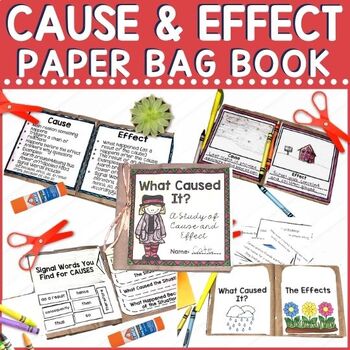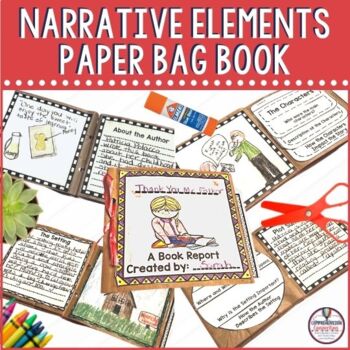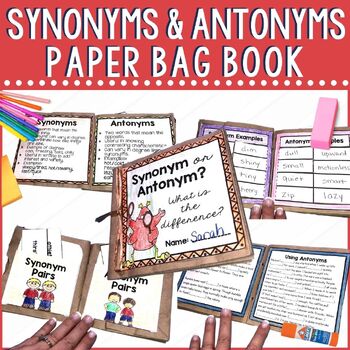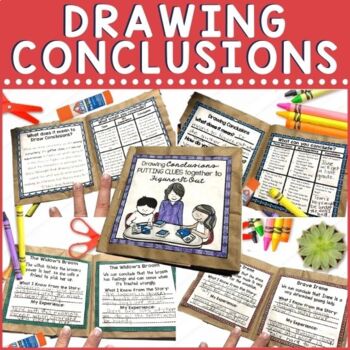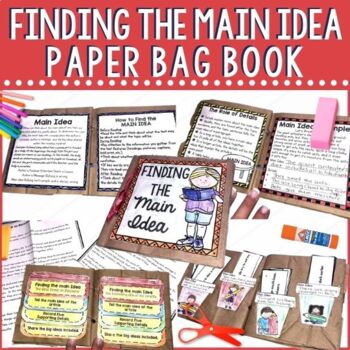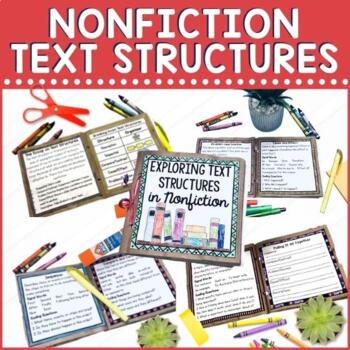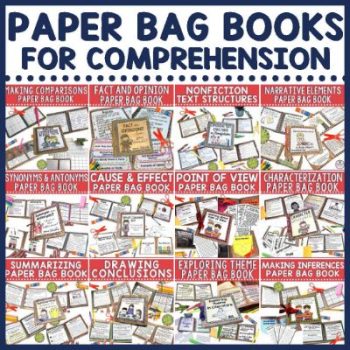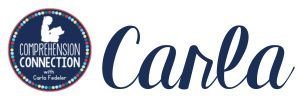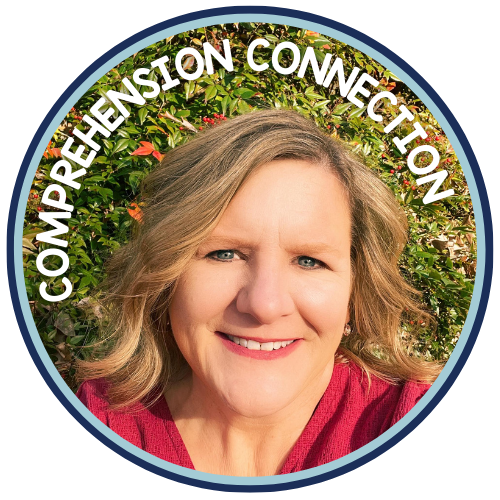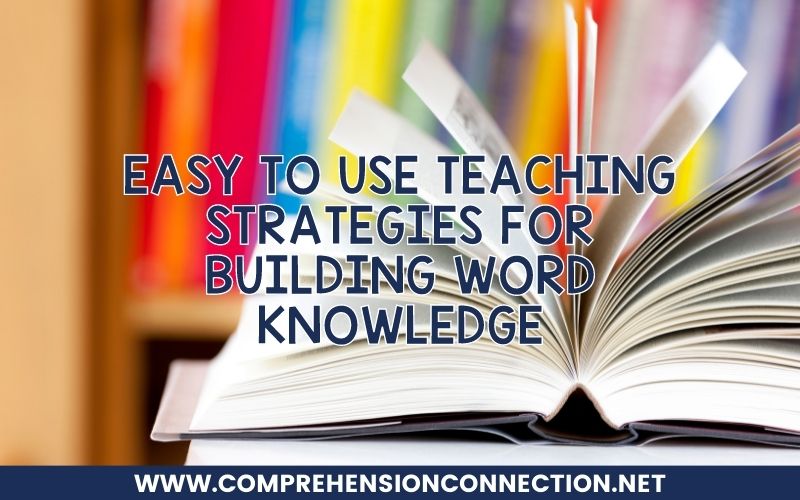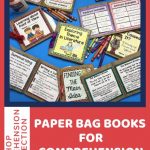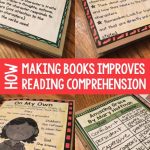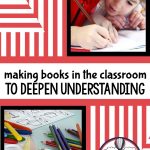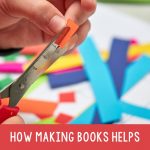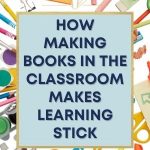
Research shows that hands-on learning such as making books helps increase student engagement and improves retention of the information learned. Kids love hands on learning. If book making is new to you, then I highly recommend giving them a try! With these book making tips, you’ll find them very effective for classroom instruction. You can use student made books in all subjects to teach concepts and to make learning memorable. I’m also excited about how the paper bag books I’ve designed will make a difference with reading comprehension and other skills too.
RESEARCH ON Making Books:
Making books in the classroom has been a well supported activity. Teachers can compile writing prompts to form class books which parents love to read on classroom visits. Why not use them for teaching too? Kids get a finished product filled with great learning, and teachers get kids who want to learn more. Whether students are writing their own books or using a book format to compile information, you can’t go wrong! Here are a few links on book making in the classroom you may find helpful:
Making books of your own:
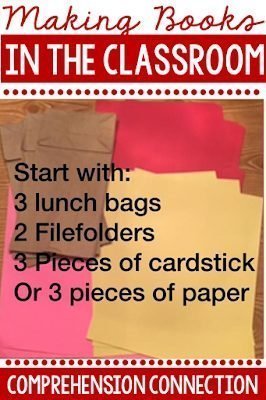
Cover Options:
First of all, you have quite a few material options for your book designs. One option I’ve enjoyed making are paper bag books, but there are times when you may not have lunch bags on hand or may need other options. If you do not have paper bags, I’ve listed a few other material options below.
- FILE FOLDERS
- COMPUTER PAPER
- CONSTRUCTION PAPER
- COLORED CARD STOCK
For the inner pages, computer paper is best. To make a 12 page book, you will need 3 pages bound in the middle. Four bound pages leads to a 16 page book.
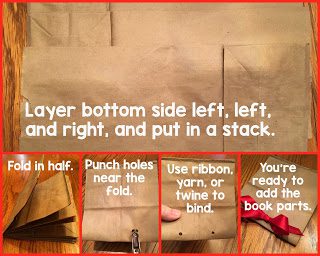
Book Dimensions
Next, you’ll need to focus on the dimensions. The dimensions of the lunch bag books are 5 1/2 x 5 1/4 when folded, so keep this in mind with the other cover options I shared. This is a nice size because it’s compact, yet big enough for students to feel like what they are making is a “real” book. Once you’ve cut your papers to the sizes listed to the right, then it’s time to fold and bind the books.
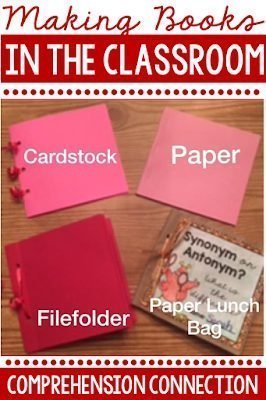
Adding Foldables to Your Student Made Books:
Finally, you might have content to add to your book such as foldables or graphic organizers. If you find you have foldables or printed pages that need to be glued into the book, I suggest keeping everything in a plastic ziplock bags. This will alleviate the headaches of lost pieces when you’re ready to have students add them. Because children can be disorganized, planning ahead makes a huge difference. I recommend forming the books on one day and working on the pages in subsequent days. That way, you don’t have to worry as much about loose pieces getting lost. You can also save printed sections until you are ready for them. Tip-Only give your students what they can manage.
How making books helps students Learn
Making books to Publish Writing Pieces
The first way we can use book making is for publishing our students’ writing. Paper bag books have been around a while for this purpose. Not every piece of writing gets published I know. However, if your students have the opportunity to publish a few, it will motivate them to want to create more. Kids love having their books as keepsakes, and once your students learn how to make the books, you can bet they’ll be more likely to try it at home. For a full sized book, you can use grocery bags which create a 9 x 12 book. These are also great for creating class books with prompts your students complete.
Content Area Interactive Notebooks
Another benefit of making books with kids is to offer an alternative to interactive notebooks. You can use many of the interactive notebook pieces and glue them to the pages of your book. This provides an opportunity for reviewing key skills. Plus, all of the concepts from your unit can be illustrated and explained in one uncluttered place,
Making books for Cross Curricular Integration
In addition to making books as a class and publishing student work, we can also use book making for cross curricular integration. We often have tactile learners in our classroom who learn best with their hands. Creative kids who prefer hands on learning need the opportunity to use their skills. It helps keep them motivated and deepens understanding.
Aside from the opportunity to illustrate a book, students can demonstrate creativity in their writing too. For example, teachers can use RAFT papers for cross curricular integration. RAFT stands for Role-Audience-Format-Topic. A RAFT paper for a unit on the plants might look like this:
- Role-Sunflower Seed
- Audience-Gardner
- Format-How To Paper
- Topic-Sunflower plant needs.
RAFT papers can even be compiled into a class book for students to observe each other’s ideas.
How making books helps with Skill Based Review and RTI
Additionally, teachers find it challenging to come up with new ways to help students with some skills. At times, teachers feel they’ve exhausted all the ways to teach challenging reading skills. In RTI sessions or in after school programs, making books might just add pizzazz to help increase student engagement. Creating books with students helps them take interest in the practice needed for the skills to stick and leads to deeper understanding.
Making BOOKS FOR COMPREHENSION Work
Recently, I’ve created sixteen different skill based books you might find helpful for skill modeling and practice, for test prep, or as a literacy station. With each of the books, there are instructional pages at the beginning that you can use in small groups to review/teach the skill. Then, the remainder of the pages are for guided and independent practice. If you’d like to see what the pages look like, just click the link to the resources where you’ll find preview images. The video below shares a little information about each book.
Making books for specific skills
FACT AND OPINION
This project includes an explanation of fact and opinion and information on signal words often used. Students practice sorting facts and opinions and explore facts and opinions in texts too.
Book Details:
- Explaining Fact and Opinion
- Fact and Opinion Flapbook
- Sorting facts and opinions
- Finding Facts and Opinions in Literature
- Signal Words Foldable
- Summarizing Facts and Opinions
CAUSE AND EFFECT RELATIONSHIPS
Teaching cause and effect relationships to students always seems challenging. With this paper bag book, students explore the difference between cause and effect, work on signal words, create example situations, sort examples, illustrate examples, find examples in reading, and explain their learning.
Project Details:
- Cause and Effect Explained
- Sorting Signal Words
- Outline an example
- Sort Statements into Cause/Effect Pockets
- Illustrate a Cause/Effect Example
- Cause and Effect in my Reading
- Summarizing My Learning
EXPLORING THEME
In this book, students write in detail about the difference between theme and main idea, sort examples, work on guiding questions and explore theme in multiple texts, and explain their learning. Here is a list of the pages included
- Elements of Theme
- Theme Flapbook (2 pages)
- Main Idea and Theme Sorting (2 pages)
- Identifying Theme in Books (2 pages)
- Guiding Questions and Text Sets that fit a common theme
- Summarizing My Learning
NARRATIVE ELEMENTS
This book was first uploaded as a book report project, but has since been revised to narrative elements. It includes a focus on character, setting, and plot. This book requires four paper bags or pages. Here’s a list of what’s included:
- Character Drawing/Labeling
- Characterization Flipbook
- Summarizing Setting
- Illustrating the Setting
- Setting Flipbook
- Plot Summary
- Plot Puzzle
- Favorite Scene Illustrated
- Quotes to Remember
- About the Author
- All about Me
SUMMARIZING
Summarizing is another skill kids seem to have trouble with. This book includes summarizing strategies that students can use to select the best summary and create their own. Here’s a list of topics included:
- Qualities of a Great Summary
- MIDAS Touch
- Summarizing Techniques
- Connections to Main Idea and Plot
- Summary Flipbook
- Summarizing Pictures
- Guiding Questions
- Writing Paragraph to Match Summary
- Summary Sorting
- Summary of my Learning
NONFICTION TEXT FEATURES
Learning how to comprehend nonfiction is so much easier if you use nonfiction text features to help you. Students often fail to realize that they don’t have to read nonfiction front to back and can use features for learning just what they need. Here’s what students learn in this book:
- Characteristics of Nonfiction
- Comparing Fiction and Nonfiction
- How Nonfiction Text Features Help Us
- Text Feature Examples
- Sorting Fiction and Nonfiction Traits
- Nonfiction Text Features Accordion Foldables
- Text Features in Books (Choose 2)
- Summarizing Your Learning
SYNONYM OR ANTONYM?
Students explore the difference between synonyms and antonyms, give examples, sort examples, explore a thesaurus and practice using it for several activities, and work on overused words in this paper bag book.
Project Details:
- Cover
- Explaining Synonyms and Antonyms
- Examples of Synonyms and Antonyms (Foldable)
- Synonym and Antonym Sorting
- Using a Thesaurus
- Overused words
- Synonyms and Antonyms in Writing
- Summarizing My Learning
DRAWING CONCLUSIONS
This paper bag book offers multiple instructional activities for teaching and practicing drawing conclusions.
- Cover
- Anchor Chart and Examples
- Drawing Conclusions Defined (what it is and is not)
- Chart Completion
- Sorting Conclusions and Simple Inferences
- Practice with The Widow’s Broom by Chris VanAllsburg
- Practice with Brave Irene
- Drawing Conclusions about ME
POINT OF VIEW
Point of view includes two terms…who is telling the story and perspective. In this book, both are addressed through the instructional pages. Then, students write about perspective and identify the point of view in multiparagraph examples. Here are the topics included:
- Point of View Anchor Chart
- Perspective versus Point of View
- How Point of View Matters
- Sorting Point of View Examples
- Summary
MAIN IDEA
Main idea is a challenging skill, and it’s one we need to practice all year. Students need to be able to identify the main idea of texts and tell how details support it. This book includes:
Project Details:
- What is the Main Idea
- How do I find the main idea?
- Connecting Main Idea and Details
- Main Idea and Details Example
- The Real Scoop about Raccoons (Flipbook)
- The Interesting Life of Giraffes (Flipbook)
- Sorting Details to Determine the Main Idea
- Main Idea with Penguins and Miss Rumphius!
- Summary of my Learning
CHARACTERIZATION
The next book included in my bundle focuses on characterization…my favorite skill to teach. I love exploring characters, and in this book, students learn about inside/outside traits, how authors directly and indirectly share traits, and more.
Here’s a list of the characterization topics and activities:
- What Characterization Means and How to Analyze
- Direct and Indirect Characterization
- Determining Traits
- On My Own Notetaking
- Characterization Flipbook
- Outside Traits in Pictures
- Sorting Positive and Negative Traits
- Characterization in Amazing Grace and Mr. Lincoln’s Way
- Summary of my Learning
MAKING INFERENCES
This book teaches students how to make inferences. Like the other books, the first few pages are dedicated to instruction and are followed by practice with different types of texts. Making inferences is a tough skill, but with this resource, you can break it down for your students.
Here’s a list of the book activities:
- Making Inferences Anchor Chart and Examples
- Making Inferences Defined (what it is and is not)
- Chart Completion
- Sorting Correct and Incorrect Inferences
- Practice with Lily’s Purple Plastic Purse
- Practice with Two Bad Ants
- Sorting Inference Truths
NONFICTION TEXT STRUCTURES
Students learn how to use text features to learn information from nonfiction books, but knowing text structures helps students recognize the important elements. Again, you can use the pages in the book as displayed or in your interactive notebooks. The first few pages explain the five structures. The last half applies them.
Here’s what you’ll find in the book:
- The Scoop on Text Structures
- Breaking Down Structures
- Anchor chart for Description, Sequential, Compare/Contrast, Cause/Effect, and Problem/Solution
- Sorting Examples
- Identifying structures in nonfiction texts (2 books from list)
- Writing Examples for each structure
- Summarizing Your Learning
To check out the full bundle, click here for TPT or buy from my site below:
-
Sale Product on saleComprehension Projects Bundle, Paper Bag Books, Test Prep, Intervention
$64.00Original price was: $64.00.$35.00Current price is: $35.00.
Final Thoughts on Making Books with your Kids
Whether your kids are writing their own books, you are making books as a class for review, or you’ve chosen one of mine to use with your kids for comprehension skills, you can not go wrong. Your kids will love it, and the finished product will make you and your kids feel proud. The wonderful thing about making books with your class is that you’ll have a finished product that you and your kids can revisit time and again.
